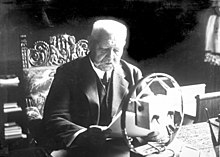Imperial broadcast

The Reichssendung was a radio program that was broadcast from 1930 to 1945 on all radio stations in Germany. It was a mouthpiece with which the government addressed the population over the radio and thus the first instrument of clear political interference in the radio program.
The first broadcasts of this kind ran from around 1930 ( Weimar Republic ), mostly every half hour between 7.30 and 8 p.m. In the German Reich under National Socialism , radio was completely synchronized , and the Reich broadcasts, with changing slots, were just one of many radio propaganda channels for the regime. What the Reich broadcasts had in common was the interconnection of all transmitters in the Reich. The technology for this was tested from 1926 onwards via telephone lines and later via a radio cable system.
Contents of the Reich broadcast
The content of the Reich broadcasts was not always political. Often they also dealt with “major topics of German culture”, such as Goethe's Faust , the Bayreuth Festival , Bach cantatas from the St. Thomas Church in Leipzig . In Reich broadcasts, Reich President Paul von Hindenburg spoke to the population, for example in 1932 on the occasion of his 85th birthday and his renewed candidacy:
The Rundfunk Jahrbuch 1933 begins an article about the technology behind the Reich broadcasts with the words:
",Attention attention! All German channels are here! Ladies and gentlemen. You are now listening to a broadcast from the Reich ', so it sounds in the broadcasting room of the Berlin radio hour, and at the same second these words radiate over all German main and secondary stations into the airwaves. Expectant people sit in the east and west, in the mountains and at the water's edge, and hear it ringing through headphones and speakers. 'Reichssendung', that must be something particularly important and valuable! Even the discerning listener with an expensive remote receiver cannot miss something like this and listens reverently to what is to come. "
From 1925 to 1931, the beaming German hour in Bavaria 20:15 to 20:45 ethnically dominated talks of Geography Professor Karl Haushofer out under the title "The World political monthly report". The series was taken out of the program because of its right-wing radicalism. After the seizure of power , the National Socialists came back to Haushofer and, from June 1933, broadcasted his “world political monthly report” on the privileged, Germany-wide broadcasting slot, as a national broadcast.
Numbers and technology
In 1932, the Reich broadcasts were an integral part of the Reichsrundfunk and were heard by most of the 4 million registered radio participants. The Rundfunk Jahrbuch 1933 has the following figures ready: At the nationwide broadcast
- 10 main channels
- 15 secondary transmitters
- 225 amplifier
- involved in 25,000 km of radio cable routes.
In addition, the Reichsrundfunk used 40,000 km of "ordinary telephone lines", i.e. the telephone network, to interconnect all transmitters. 450 tubes were in use, from the battery-powered 4 volt tube to the 320 kilowatt transmitter tube. No exact figures are known about the total staff of German radio at that time. The yearbook states that 200 employees throughout the Reich were specifically involved in the transmission of Reich broadcasts.
When Hindenburg's speech was broadcast in March 1932 from the Reich President's Palace, the radio house in Berlin's Wilhelmstrasse was the control center for the other broadcasters in the Reich. There was a lot of press. Immediately in front of the switch , while checking the transmission paths , the technicians discovered that there was “a thick tone on the line”, i.e. a hum. They changed the transmission paths twice, the humming tone remained. Eventually a radio engineer came up with the idea that the power cables for the movie cameras could scatter. The yearbook writes:
- “Now it's time to act quickly. Pliers here, pinched off! New cables quickly pulled as far as possible from the thick and thin sound film lines on the floor. [...] Oh, how good it was that the gentleman in Stuttgart [meaning the moderator] couldn't finish earlier! This gain in time saved us from failing. [...] It is just now coming from the house of the radio: everything is fine! Then the door opens: the Reich President appears. You can no longer hear a sound - and his deep and sonorous voice can already be heard from millions of German comrades. "
By the beginning of the Second World War , the number of radio listeners in Germany had tripled compared to 1932, so that radio broadcasts were of increasing importance for the formation of public opinion. The number of radio receivers that were available in Germany in 1941 is estimated at a good 16 million. That is why those in power regarded radio as "the most modern and most important instrument for influencing the masses that exists".
Individual evidence
- ↑ Rundfunk Jahrbuch 1933. Published by the working group of publishers of official radio magazines and the Reichs-Rundfunk-Gesellschaft . Verlag JS Preuß, Berlin 1932, p. 77ff. The book is in the library of the Museum for Communication Frankfurt .
- ↑ Ulrich Heitger: From time signals to political means of leadership. Development tendencies and structures of radio news programs in the Weimar Republic 1923–1932. Lit Verlag, 2003, ISBN 3-8258-6853-2 , p. 196f.
- ↑ a b Bernd-Jürgen Wendt: Germany 1933–1945: The "Third Reich". History manual . Fackelträger Verlag, Hannover 1995, ISBN 3-7716-2209-3 , p. 317.
- ↑ Yearbook, pp. 81f.
- ^ Hans-Ulrich Wehler: German history of society. From the beginning of the First World War to the founding of the two German states: 1914–1949. CH Beck Verlag, Munich 2003. At the same time: Federal Agency for Civic Education, Bonn 2009, ISBN 978-3-89331-954-1 , pp. 839f.
